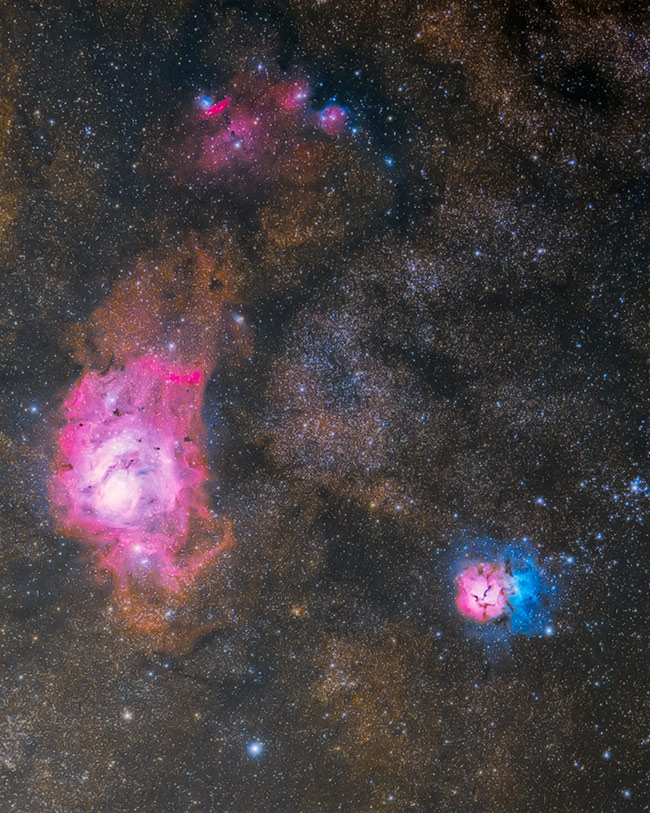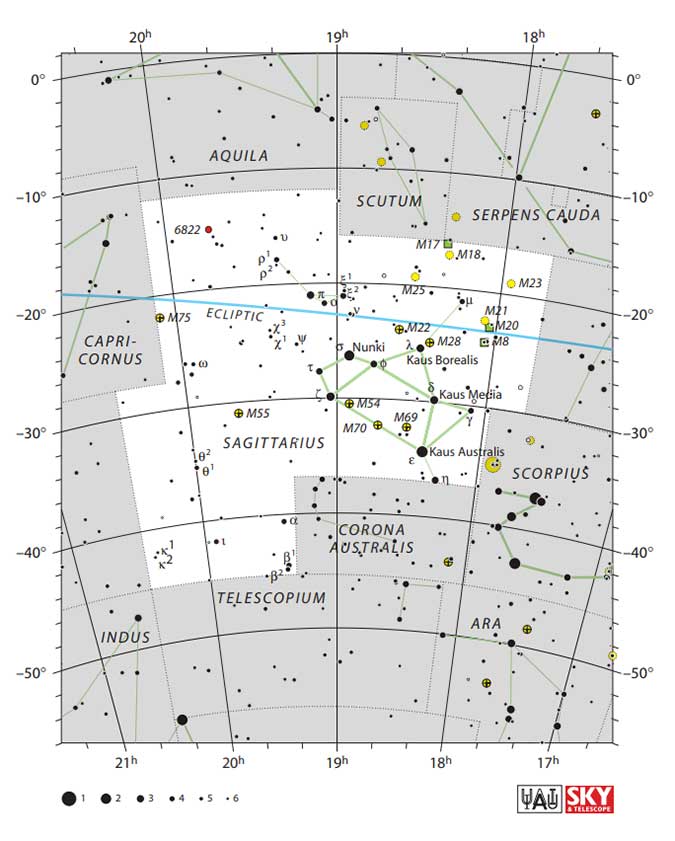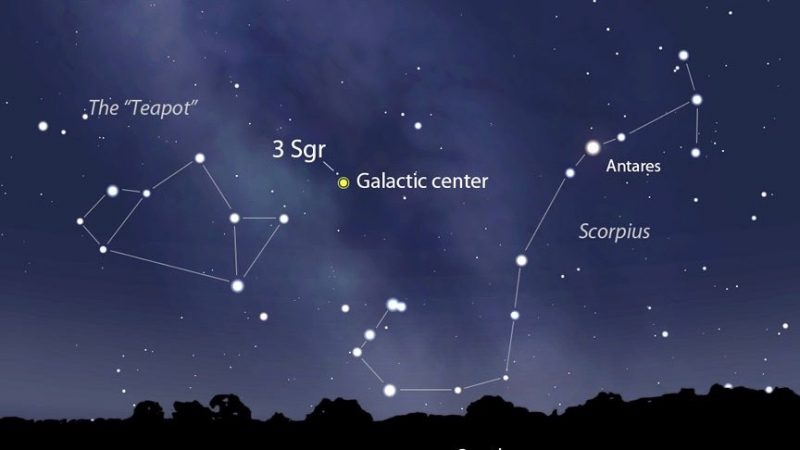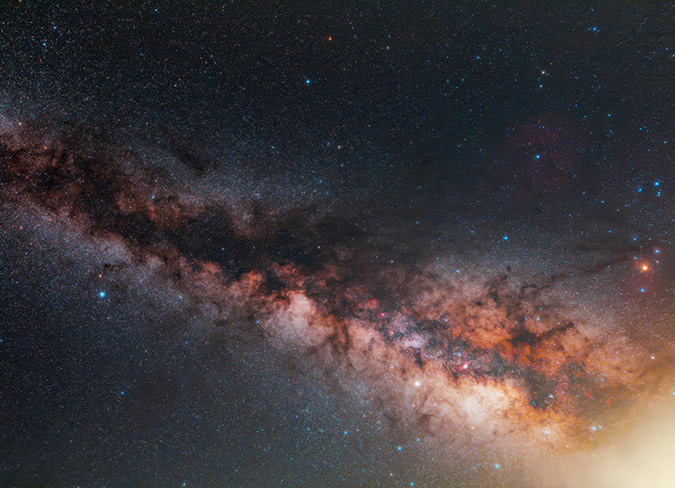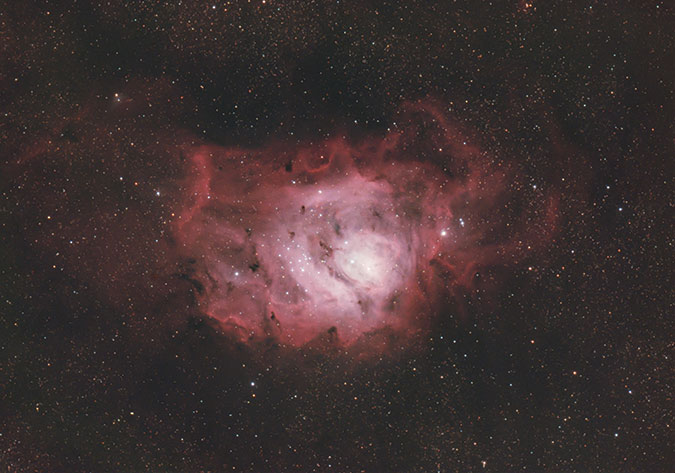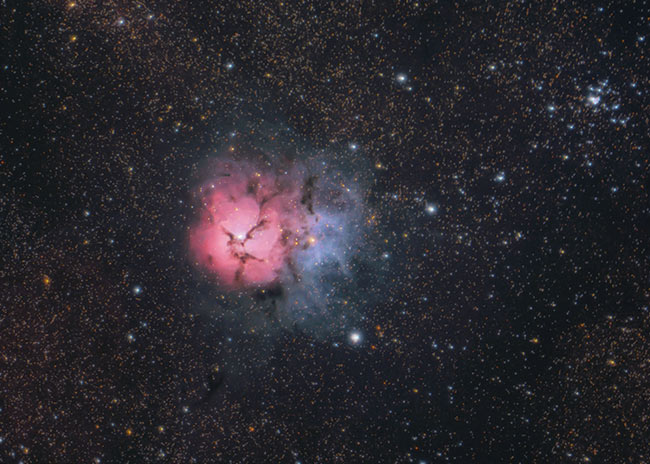Sagittarius Constellation
Sagittarius is one of the 88 modern constellations, and one of the 12 constellations of the zodiac. It is commonly depicted as a centaur pulling back a bow, but many amateur astronomers in the northern hemisphere view Sagittarius as a more recognizable “teapot” asterism.
The Sagittarius constellation has an interesting history, and also contains some of the most popular deep-sky objects in the night sky. For example, Sagittarius contains a pair of emission and reflection nebulae, the Lagoon and Trifid Nebulae. Not only are they arguably two of the most beautiful star-forming regions in the night sky, but they also fit within a 5-degree wide field of view.
Bright Nebulae in the constellation Sagittarius.
The Constellation Saggitarius
Saggitarius is one of the more interesting constellations in the night sky due to the many bright Messier objects within it. In the northern hemisphere, Sagittarius signifies the return of warmer weather and many fascinating telescopic objects. I highly recommend spending time in this area of the night sky with your binoculars or Dobsonian telescope and eyepiece (here is the telescope I recommend).
- Abbreviation: Sgr
- Symbolism: The Archer
- Right ascension: 19h
- Declination: −25°
- Quadrant: SQ4
- Size: 867 sq. deg. (15th largest)
- Brightest Star: Kaus Australis
- Messier Objects: 15
Sagittarius borders on 10 constellations in the night sky; Aquila, Scutum, Serpens Cauda, Ophiuchus, Scorpius, Corona Australis, Telescopium, Indus (corner), MicroscopiumCapricornus. In the image below, you’ll notice how Sagittarius sits low in the sky near the core of the Milky Way from my location at 43° North.
Sagittarius and the “Teapot” asterism in the Milky Way.
The photo above was captured using a DSLR camera on a stationary tripod from a dark sky site. To learn how to take pictures like this with your camera, see my Milky Way photography tips.
Location in the Sky
Sagittarius is the 15th biggest constellation in the sky with a surface area of 867 square degrees. If you want to get more technical, the constellation is placed in the fourth quadrant of the southern hemisphere i.e. SQ4, and is visible in the latitudes between +55 and -90.
The constellation is quite easy to locate given its one of the largest in the southern sky. As a whole, this constellation is often viewed as having an approximate appearance of a stick figurine drawing an arrow from a bow.
Sagittarius Star Map. IUA and Sky and Telescope.
The arrow is pointed at the heart of Scorpius. The neighboring constellations include Aquila, Capricornus, Indus, Microscopium, and Scutum. Moreover, Sagittarius’ brightest stars also form a pattern of a teapot.
The following star map shared by Astro Bob is a great representation of the Sagittarius constellation from mid-northern latitudes. The spout of the “Teapot” pours directly into the Galactic center.
Like many other zodiac constellations, Sagittarius was first cataloged by a Greek astronomer by the name of Ptolemy in the 2nd century.
Ptolemy is best known for his mathematical model of the universe, and the influence it had on medieval astronomy in the Islamic world and Europe. He understood that the irregular paths of the Sun, Moon, and planets were a combination of many regular circular motions seen from the perspective of a stationary Earth.
Observing
As Sagittarius is a summer constellation, if you wish to see it, your best bet would be from June through August. Technically the best viewing of Sagittarius is in August at around 9 pm.
By September, Sagittarius begins to set by sunset. The easiest way to locate Sagittarius would be to first locate the Milky Way and then going southward.
Because this constellation sits rather low in the sky from the perspective of the northern hemisphere, you may not have a great view of it from your backyard. Trees, houses, and other obstructions may block a portion of the constellation from your home.
If this is the case, get to a location with a low view of the southern horizon to see Saggitarius in all its glory.
The “Teapot” asterism spills into the core of the Milky Way.
As is common with all the constellations, the perfect way to view Sagittarius would be outside of the city during a dark sky. But since the stars of this constellation are quite bright, you should be able to see its basic shape even if the moon is up.
However, if you’re from Scotland or a part of any Scandinavian country, I’ve got bad news for you as you will not be able to see the constellation at all.
Stars
Kaus Australis:
Also known as Epsilon Sagittari, it is the brightest star in the Sagittarius constellation with a magnitude of 1.79. Just for the sake of comparison, Kaus Australis is 375 times more luminous than the Sun. It is also the 36th brightest star in the sky. Its distance from our planet is that of 143 light-years. The star’s name is a mixture of Arabic and Latin. Moreover, Kaus Australis acts as the base of the archer’s bow.
Nunki:
Nunki or Sigma Sagittari has a magnitude of 2.1 and therefore is the second brightest star within the constellation. (Note: Take a deep breath before reading the following sentence) The star is 3300 times more luminous than our Sun, and is 100 times faster than it with a speed of 200 km/s!
Nunki is approximately 228 light-years away from the Earth. There is no general consensus upon the origins of Nunki’s name. Some argue that its Babylonian while some claim its Assyrian.
Kaus Media:
The third brightest star within the constellation of today’s topic is, Kaus Media or Delta Sagittarii. It has a magnitude of 2.72 and is thus 1180 times more luminous than the Sun.
Kaus Media is 306 light-years away from our planet and it is part of the spectral type K3III. The star’s name means “the middle bow”.
Kaus Media is a multiple star system. In pop-culture, this system is known in the 1969 novel Into the Sea of Stars by William R. Forstchen.
Mythology
According to the Babylonians, Sagittarius is associated with the god Pabilsag. Pabilsag is an unusual centaur-like creature who fires arrows. What’s strange about this centaur is that it has wings, two heads, of which one is that of a panther and the other is a human head.
Moreover, in Babylonian’s traditions, this centaur also has the stinger of a scorpion that is placed above its horse tail. The word Pabilsag is roughly translated into “Forefather”. This creature is also sometimes referred to as “the wild bull with multicolored legs.”
Greek mythology describes the centaur as having the torso of the human and the body and four legs of a horse. As the Greeks adopted the Sumerian tradition, there is a debate about the identity of the archer.
Some claim that Sagittarius is, in fact, the centaur Chiron, who converted himself into a horse to free himself of his jealous wife. But some argue that given the fact that there are two centaur constellations in the sky, Chiron is related to the constellation called Centaurus.
Another tradition by Eratosthenes claims that this archer is not even a centaur but is the satyr Crotus- the son of Pan, which the Greek mythology accredits with the invention of archery.
According to this tradition, Crotus would frequently go hunting and lived with the Muses. They requested Zeus to place Crotus in the sky, where he can be remembered and seen by as all as demonstrating archery.
Deep-Sky Objects in Sagittarius
- M17: The Omega Nebula
- M20: The Trifid Nebula
- M8: The Lagoon Nebula
- M24: Small Sagittarius Star Cloud
- IC 1284 Emission Nebula
The Trifid Nebula in Sagittarius.
